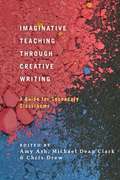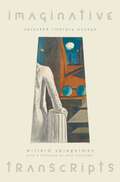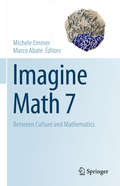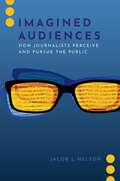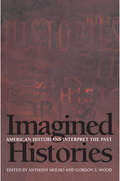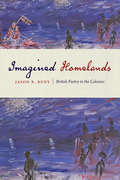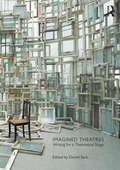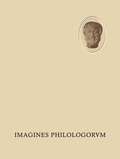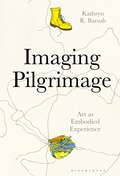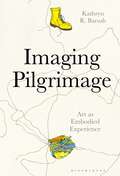- Table View
- List View
The Imaginative Argument: A Practical Manifesto for Writers
by Frank L. CioffiMore than merely a writing text, The Imaginative Argument offers writers instruction on how to use their imaginations to improve their prose. Cioffi shows writers how they can enliven argument--the organizing rubric of all persuasive writing--by drawing on emotion, soul, and creativity, the wellsprings of imagination. While Cioffi suggests that argument should become a natural habit of mind for writers, he goes still further, inspiring writers to adopt as their gold standard the imaginative argument: the surprising yet strikingly apt insight that organizes disparate noises into music, that makes out of chaos, chaos theory. Rather than offering a model of writing based on established formulas or templates, Cioffi urges writers to envision argument as an active parsing of experience that imaginatively reinvents the world. Cioffi's manifesto asserts that successful argument also requires writers to explore their own deep-seated feelings, to exploit the fuzzy but often profoundly insightful logic of the imagination. But expression is not all that matters: Cioffi's work anchors itself in the actual. Drawing on Louis Kahn's notion that a good architect never has all the answers to a building's problems before its physical construction, Cioffi maintains that in argument, too, answers must be forged along the way, as the writer inventively deals with emergent problems and unforeseen complexities. Indeed, discovery, imagination, and invention suffuse all stages of the process. The Imaginative Argument offers all the intellectual kindling that writers need to ignite this creativity, from insights on developing ideas to avoiding bland assertions or logical leaps. It cites exemplary nonfiction prose stylists, including William James, Ruth Benedict, and Erving Goffman, as well as literary sources to demonstrate the dynamic of persuasive writing. Provocative and lively, it will prove not only essential reading but also inspiration for all those interested in arguing more imaginatively more successfully. This edition features new chapters that cover the revision process in greater depth, as well as the particular challenges of researching and writing in the digital age, such as working with technology and avoiding plagiarism. The book also includes new sample essays, an appendix to help instructors use the book in the classroom, and much more.
The Imaginative Argument: A Practical Manifesto for Writers
by Frank L. CioffiMore than merely a writing text, The Imaginative Argument offers writers instruction on how to use their imaginations to improve their prose. Cioffi shows writers how they can enliven argument--the organizing rubric of all persuasive writing--by drawing on emotion, soul, and creativity, the wellsprings of imagination. While Cioffi suggests that argument should become a natural habit of mind for writers, he goes still further, inspiring writers to adopt as their gold standard the imaginative argument: the surprising yet strikingly apt insight that organizes disparate noises into music, that makes out of chaos, chaos theory. Rather than offering a model of writing based on established formulas or templates, Cioffi urges writers to envision argument as an active parsing of experience that imaginatively reinvents the world. Cioffi's manifesto asserts that successful argument also requires writers to explore their own deep-seated feelings, to exploit the fuzzy but often profoundly insightful logic of the imagination. But expression is not all that matters: Cioffi's work anchors itself in the actual. Drawing on Louis Kahn's notion that a good architect never has all the answers to a building's problems before its physical construction, Cioffi maintains that in argument, too, answers must be forged along the way, as the writer inventively deals with emergent problems and unforeseen complexities. Indeed, discovery, imagination, and invention suffuse all stages of the process. The Imaginative Argument offers all the intellectual kindling that writers need to ignite this creativity, from insights on developing ideas to avoiding bland assertions or logical leaps. It cites exemplary nonfiction prose stylists, including William James, Ruth Benedict, and Erving Goffman, as well as literary sources to demonstrate the dynamic of persuasive writing. Provocative and lively, it will prove not only essential reading but also inspiration for all those interested in arguing more imaginatively more successfully. This edition features new chapters that cover the revision process in greater depth, as well as the particular challenges of researching and writing in the digital age, such as working with technology and avoiding plagiarism. The book also includes new sample essays, an appendix to help instructors use the book in the classroom, and much more.
The Imaginative Argument: A Practical Manifesto for Writers - Second Edition
by Frank L. CioffiMore than merely a writing text, The Imaginative Argument offers writers instruction on how to use their imaginations to improve their prose. Cioffi shows writers how they can enliven argument—the organizing rubric of all persuasive writing—by drawing on emotion, soul, and creativity, the wellsprings of imagination. While Cioffi suggests that argument should become a natural habit of mind for writers, he goes still further, inspiring writers to adopt as their gold standard the imaginative argument: the surprising yet strikingly apt insight that organizes disparate noises into music, that makes out of chaos, chaos theory.Rather than offering a model of writing based on established formulas or templates, Cioffi urges writers to envision argument as an active parsing of experience that imaginatively reinvents the world. Cioffi's manifesto asserts that successful argument also requires writers to explore their own deep-seated feelings, to exploit the fuzzy but often profoundly insightful logic of the imagination.But expression is not all that matters: Cioffi's work anchors itself in the actual. Drawing on Louis Kahn's notion that a good architect never has all the answers to a building's problems before its physical construction, Cioffi maintains that in argument, too, answers must be forged along the way, as the writer inventively deals with emergent problems and unforeseen complexities. Indeed, discovery, imagination, and invention suffuse all stages of the process.The Imaginative Argument offers all the intellectual kindling that writers need to ignite this creativity, from insights on developing ideas to avoiding bland assertions or logical leaps. It cites exemplary nonfiction prose stylists, including William James, Ruth Benedict, and Erving Goffman, as well as literary sources to demonstrate the dynamic of persuasive writing. Provocative and lively, it will prove not only essential reading but also inspiration for all those interested in arguing more imaginatively more successfully.This edition features new chapters that cover the revision process in greater depth, as well as the particular challenges of researching and writing in the digital age, such as working with technology and avoiding plagiarism. The book also includes new sample essays, an appendix to help instructors use the book in the classroom, and much more.
Imaginative Teaching through Creative Writing: A Guide for Secondary Classrooms
by Amy Ash, Michael Dean Clark, and Chris DrewGrowing out of recent pedagogical developments in creative writing studies and perceived barriers to teaching the subject in secondary education schools, this book creates conversations between secondary and post-secondary teachers aimed at introducing and improving creative writing instruction in teaching curricula for young people. Challenging assumptions and lore regarding the teaching of creative writing, this book examines new and engaging techniques for infusing creative writing into all types of language arts instruction, offering inclusive and pedagogically sound alternatives that consider the needs of a diverse range of students. With careful attention given to creative writing within current standards-based educational systems, Imaginative Teaching Through Creative Writing confronts and offers solutions to the perceived difficulty of teaching the subject in such environments. Divided into two sections, section one sees post-secondary instructors address pedagogical techniques and concerns such as workshop, revision, and assessment before section two explores hands-on activities and practical approaches to instruction. Focusing on an invaluable and underrepresented area of creative writing studies, this book begins a much-needed conversation about the future of creative writing instruction at all levels and the benefits of collaboration across the secondary/post-secondary divide.
Imaginative Teaching through Creative Writing: A Guide for Secondary Classrooms
Growing out of recent pedagogical developments in creative writing studies and perceived barriers to teaching the subject in secondary education schools, this book creates conversations between secondary and post-secondary teachers aimed at introducing and improving creative writing instruction in teaching curricula for young people. Challenging assumptions and lore regarding the teaching of creative writing, this book examines new and engaging techniques for infusing creative writing into all types of language arts instruction, offering inclusive and pedagogically sound alternatives that consider the needs of a diverse range of students. With careful attention given to creative writing within current standards-based educational systems, Imaginative Teaching Through Creative Writing confronts and offers solutions to the perceived difficulty of teaching the subject in such environments. Divided into two sections, section one sees post-secondary instructors address pedagogical techniques and concerns such as workshop, revision, and assessment before section two explores hands-on activities and practical approaches to instruction. Focusing on an invaluable and underrepresented area of creative writing studies, this book begins a much-needed conversation about the future of creative writing instruction at all levels and the benefits of collaboration across the secondary/post-secondary divide.
Imaginative Transcripts: Selected Literary Essays
by Willard SpiegelmanWillard Spiegelman is considered one of the finest critics of poetry writing today and this volume collects his best work on the subject, offering essays that span his entire career and chart his changing relationship to an elusive form. He takes the measure of a wide spectrum of poetry, ranging from the Romantic era to the present, through an examination of those poets whose language, formal experiments, and music have fascinated him throughout his career. With his trademark engaging and stylish prose, Spiegelman takes readers on a tour of the rich and diverse landscape of British and American poetry, as he provides nuanced, insightful readings of works by William Wordsworth, John Keats, Robert Lowell, Elizabeth Bishop, and John Ashbery, to name just a few.
Imagine Math 7: Between Culture and Mathematics
Imagine mathematics, imagine with the help of mathematics, imagine new worlds, new geometries, new forms. Imagine building mathematical models that make it possible to manage our world better, imagine solving great problems, imagine new problems never before thought of, imagine combining music, art, poetry, literature, architecture, theatre and cinema with mathematics. Imagine the unpredictable and sometimes counterintuitive applications of mathematics in all areas of human endeavour. This seventh volume starts with a homage to the Italian artist Mimmo Paladino who created exclusively for the Venice Conference 2019 ten original and unique works of art paper dedicated to the themes of the meeting. A large section is dedicated to the most recent Fields Medals including a Homage to Maryam Mirzakhani including a presentation of the exhibition on soap bubbles in art and science that took place in 2019. A section is dedicated to cinema and theatre including the performances by Claire Bardainne & Adrien Mondot. A part of the conference focused on the community of mathematicians, their role in literature and even in politics with the extraordinary example of Antanas Mockus Major of Bogotá. Mathematics in the constructions of bridges, in particular in Italy in the Sixties was presented by Tullia Iori. A very particular contribution on Origami by a mathematician, Marco Abate and an artist, Alessandro Beber. And many other topics. As usual the topics are treated in a way that is rigorous but captivating, detailed and full of evocations. This is an all-embracing look at the world of mathematics and culture. The world, life, culture, everything has changed in a few weeks with the Coronavirus. Culture, science are the main ways to safeguard people's physical and social life. Trust in humanity's creativity and ability. The motto today in Italy is Everything will be fine.This work is addressed to all those who have an interest in Mathematics.
Imagined Audiences: How Journalists Perceive and Pursue the Public (Journalism and Political Communication Unbound)
by Jacob L. NelsonMany believe the solution to ongoing crises in the news industry--including profound financial instability and public distrust--is for journalists to improve their relationship with their audiences. This raises important questions: How do journalists conceptualize their audiences in the first place? What is the connection between what journalists think about their audiences and what they do to reach them? Perhaps most importantly, how aligned are these "imagined" audiences with the real ones? Imagined Audiences draws on ethnographic case studies of three news organizations to reveal how journalists' assumptions about their audiences shape their approaches to their audiences. Jacob L. Nelson examines the role that audiences have traditionally played in journalism, how that role has changed, and what those changes mean for both the profession and the public. He concludes by drawing on audience studies research to compare journalism's "imagined" audiences with actual observations of news audience behavior. The result is a comprehensive study of both news production and reception at a moment when the relationship between the two has grown more important than ever before.
IMAGINED AUDIENCES C: How Journalists Perceive and Pursue the Public (Journalism and Political Communication Unbound)
by Jacob L. NelsonMany believe the solution to ongoing crises in the news industry--including profound financial instability and public distrust--is for journalists to improve their relationship with their audiences. This raises important questions: How do journalists conceptualize their audiences in the first place? What is the connection between what journalists think about their audiences and what they do to reach them? Perhaps most importantly, how aligned are these "imagined" audiences with the real ones? Imagined Audiences draws on ethnographic case studies of three news organizations to reveal how journalists' assumptions about their audiences shape their approaches to their audiences. Jacob L. Nelson examines the role that audiences have traditionally played in journalism, how that role has changed, and what those changes mean for both the profession and the public. He concludes by drawing on audience studies research to compare journalism's "imagined" audiences with actual observations of news audience behavior. The result is a comprehensive study of both news production and reception at a moment when the relationship between the two has grown more important than ever before.
Imagined Commonwealth: Cambridge Essays on Commonwealth and International Literature in English (Cambridge Commonwealth Series)
by T. J. CribbThis collection includes contributions from some of the major authors in the field. The critical essays have been chosen to open up possibilities, mark out boundaries and set objectives in the ever-expanding field of international literature in English. The writers themselves are the principal guides and resources for this enterprise. New literary and critical practices are derived from the problematic role of English as an international language and from its relations with other languages. Values of cultural difference and particularity are emphasised.
Imagined Communities and Educational Possibilities: A Special Issue of the journal of Language, Identity, and Education
by Yasuko Kanno Bonny NortonImagined Communities and Educational Possibilities focuses on three main themes: imaged communities expand the range of possible selves, technological advances in the last two decades have had a significant impact on what is possible to imagine, and imagination at even the most personal level is related to social ideologies and hegemonies. The diverse studies in this issue demonstrate convincingly that learners and teachers are capable of imagining the world as different from prevailing realities. Moreover, time and energy can be invested to strive for the realization of alternative visions of the future. Research in this special issue suggests that investment in such imagined communities offers intriguing possibilities for social and educational change.
Imagined Communities and Educational Possibilities: A Special Issue of the journal of Language, Identity, and Education
by Thomas Ricento Terrence G. WileyImagined Communities and Educational Possibilities focuses on three main themes: imaged communities expand the range of possible selves, technological advances in the last two decades have had a significant impact on what is possible to imagine, and imagination at even the most personal level is related to social ideologies and hegemonies. The diverse studies in this issue demonstrate convincingly that learners and teachers are capable of imagining the world as different from prevailing realities. Moreover, time and energy can be invested to strive for the realization of alternative visions of the future. Research in this special issue suggests that investment in such imagined communities offers intriguing possibilities for social and educational change.
Imagined Futures: Writing, Science, and Modernity in the To-Day and To-Morrow Book Series, 1923-31
by Max SaundersThis study provides the first substantial history and analysis of the To-Day and To-Morrow series of 110 books, published by Kegan Paul Trench and Trübner (and E. P. Dutton in the USA) from 1923 to 1931, in which writers chose a topic, described its present, and predicted its future. Contributors included J. B. S. Haldane, Bertrand Russell, Vernon Lee, Robert Graves, Vera Brittain, Sylvia Pankhurst, Hugh McDiarmid, James Jeans, J. D. Bernal, Winifred Holtby, André Maurois, and many others. The study combines a comprehensive account of its interest, history, and range with a discussion of its key concerns, tropes, and influence. The argument focuses on science and technology, not only as the subject of many of the volumes, but also as method—especially through the paradigm of the human sciences—applied to other disciplines; and as a source of metaphors for representing other domains. It also includes chapters on war, technology, cultural studies, and literature and the arts. This book aims to reinstate the series as a vital contribution to the writing of modernity, and to reappraise modernism's relation to the future, establishing a body of progressive writing which moves beyond the discourses of post-Darwinian degeneration and post-war disenchantment, projecting human futures rather than mythic or classical pasts. It also shows how, as a co-ordinated body of futurological writing, the series is also revealing about the nature and practices of modern futurology itself.
Imagined Futures: Writing, Science, and Modernity in the To-Day and To-Morrow Book Series, 1923-31
by Max SaundersThis study provides the first substantial history and analysis of the To-Day and To-Morrow series of 110 books, published by Kegan Paul Trench and Trübner (and E. P. Dutton in the USA) from 1923 to 1931, in which writers chose a topic, described its present, and predicted its future. Contributors included J. B. S. Haldane, Bertrand Russell, Vernon Lee, Robert Graves, Vera Brittain, Sylvia Pankhurst, Hugh McDiarmid, James Jeans, J. D. Bernal, Winifred Holtby, André Maurois, and many others. The study combines a comprehensive account of its interest, history, and range with a discussion of its key concerns, tropes, and influence. The argument focuses on science and technology, not only as the subject of many of the volumes, but also as method—especially through the paradigm of the human sciences—applied to other disciplines; and as a source of metaphors for representing other domains. It also includes chapters on war, technology, cultural studies, and literature and the arts. This book aims to reinstate the series as a vital contribution to the writing of modernity, and to reappraise modernism's relation to the future, establishing a body of progressive writing which moves beyond the discourses of post-Darwinian degeneration and post-war disenchantment, projecting human futures rather than mythic or classical pasts. It also shows how, as a co-ordinated body of futurological writing, the series is also revealing about the nature and practices of modern futurology itself.
Imagined Histories: American Historians Interpret the Past (PDF)
by Anthony Molho Gordon S. WoodThis collection of essays by twenty-one distinguished American historians reflects on a peculiarly American way of imagining the past. At a time when history-writing has changed dramatically, the authors discuss the birth and evolution of historiography in this country, from its origins in the late nineteenth century through its present, more cosmopolitan character. In the book's first part, concerning recent historiography, are chapters on exceptionalism, gender, economic history, social theory, race, and immigration and multiculturalism. Authors are Daniel Rodgers, Linda Kerber, Naomi Lamoreaux, Dorothy Ross, Thomas Holt, and Philip Gleason. The three American centuries are discussed in the second part, with chapters by Gordon Wood, George Fredrickson, and James Patterson. The third part is a chronological survey of non-American histories, including that of Western civilization, ancient history, the middle ages, early modern and modern Europe, Russia, and Asia. Contributors are Eugen Weber, Richard Saller, Gabrielle Spiegel, Anthony Molho, Philip Benedict, Richard Kagan, Keith Baker, Joseph Zizak, Volker Berghahn, Charles Maier, Martin Malia, and Carol Gluck. Together, these scholars reveal the unique perspective American historians have brought to the past of their own nation as well as that of the world. Formerly writing from a conviction that America had a singular destiny, American historians have gradually come to share viewpoints of historians in other countries about which they write. The result is the virtual disappearance of what was a distinctive American voice. That voice is the subject of this book.
Imagined Homelands: British Poetry in the Colonies
by Jason R. RudyImagined Homelands chronicles the emerging cultures of nineteenth-century British settler colonialism, focusing on poetry as a genre especially equipped to reflect colonial experience. Jason Rudy argues that the poetry of Victorian-era Australia, New Zealand, South Africa, and Canada;¢;‚¬;€?often disparaged as derivative and uncouth;¢;‚¬;€?should instead be seen as vitally engaged in the social and political work of settlement. The book illuminates cultural pressures that accompanied the unprecedented growth of British emigration across the nineteenth century. It also explores the role of poetry as a mediator between familiar British ideals and new colonial paradigms within emerging literary markets from Sydney and Melbourne to Cape Town and Halifax. Rudy focuses on the work of poets both canonical;¢;‚¬;€?including Tennyson, Browning, Longfellow, and Hemans;¢;‚¬;€?and relatively obscure, from Adam Lindsay Gordon, Susanna Moodie, and Thomas Pringle to Henry Kendall and Alexander McLachlan. He examines in particular the nostalgic relations between home and abroad, core and periphery, whereby British emigrants used both original compositions and canonical British works to imagine connections between their colonial experiences and the lives they left behind in Europe.Drawing on archival work from four continents, Imagined Homelands insists on a wider geographic frame for nineteenth-century British literature. From lyrics printed in newspapers aboard emigrant ships heading to Australia and South Africa, to ballads circulating in New Zealand and Canadian colonial journals, poetry was a vibrant component of emigrant life. In tracing the histories of these poems and the poets who wrote them, this book provides an alternate account of nineteenth-century British poetry and, more broadly, of settler colonial culture.
Imagined Homelands: British Poetry in the Colonies
by Jason R. RudyImagined Homelands chronicles the emerging cultures of nineteenth-century British settler colonialism, focusing on poetry as a genre especially equipped to reflect colonial experience. Jason Rudy argues that the poetry of Victorian-era Australia, New Zealand, South Africa, and Canada;¢;‚¬;€?often disparaged as derivative and uncouth;¢;‚¬;€?should instead be seen as vitally engaged in the social and political work of settlement. The book illuminates cultural pressures that accompanied the unprecedented growth of British emigration across the nineteenth century. It also explores the role of poetry as a mediator between familiar British ideals and new colonial paradigms within emerging literary markets from Sydney and Melbourne to Cape Town and Halifax. Rudy focuses on the work of poets both canonical;¢;‚¬;€?including Tennyson, Browning, Longfellow, and Hemans;¢;‚¬;€?and relatively obscure, from Adam Lindsay Gordon, Susanna Moodie, and Thomas Pringle to Henry Kendall and Alexander McLachlan. He examines in particular the nostalgic relations between home and abroad, core and periphery, whereby British emigrants used both original compositions and canonical British works to imagine connections between their colonial experiences and the lives they left behind in Europe.Drawing on archival work from four continents, Imagined Homelands insists on a wider geographic frame for nineteenth-century British literature. From lyrics printed in newspapers aboard emigrant ships heading to Australia and South Africa, to ballads circulating in New Zealand and Canadian colonial journals, poetry was a vibrant component of emigrant life. In tracing the histories of these poems and the poets who wrote them, this book provides an alternate account of nineteenth-century British poetry and, more broadly, of settler colonial culture.
Imagined Theatres: Writing for a Theoretical Stage
by Daniel SackImagined Theatres collects theoretical dramas written by some of the leading scholars and artists of the contemporary stage. These dialogues, prose poems, and microfictions describe imaginary performance events that explore what might be possible and impossible in the theatre. Each scenario is mirrored by a brief accompanying reflection, asking what they might mean for our thinking about the theatre. These many possible worlds circle around questions that include: In what way is writing itself a performance? How do we understand the relationship between real performances that engender imaginary reflections and imaginary conceptions that form the basis for real theatrical productions? Are we not always imagining theatres when we read or even when we sit in the theatre, watching whatever event we imagine we are seeing?
Imagined Theatres: Writing for a Theoretical Stage
by Daniel SackImagined Theatres collects theoretical dramas written by some of the leading scholars and artists of the contemporary stage. These dialogues, prose poems, and microfictions describe imaginary performance events that explore what might be possible and impossible in the theatre. Each scenario is mirrored by a brief accompanying reflection, asking what they might mean for our thinking about the theatre. These many possible worlds circle around questions that include: In what way is writing itself a performance? How do we understand the relationship between real performances that engender imaginary reflections and imaginary conceptions that form the basis for real theatrical productions? Are we not always imagining theatres when we read or even when we sit in the theatre, watching whatever event we imagine we are seeing?
Imagines Philologorvm: 160 Bildnisse aus der Zeit von der Renaissance bis zur Gegenwart
by Alfred GudemanDieser Buchtitel ist Teil des Digitalisierungsprojekts Springer Book Archives mit Publikationen, die seit den Anfängen des Verlags von 1842 erschienen sind. Der Verlag stellt mit diesem Archiv Quellen für die historische wie auch die disziplingeschichtliche Forschung zur Verfügung, die jeweils im historischen Kontext betrachtet werden müssen. Dieser Titel erschien in der Zeit vor 1945 und wird daher in seiner zeittypischen politisch-ideologischen Ausrichtung vom Verlag nicht beworben.
Imaging Pilgrimage: Art as Embodied Experience
by Kathryn BarushWhile place-based pilgrimage is an embodied practice, can it be experienced in its fullness through built environments,assemblages of souvenirs, and music? Imaging Pilgrimage explores contemporary art that is created after a pilgrimage and intended to act as a catalyst for the embodied experience of others. Each chapter focuses on a contemporary artwork that links one landscape to another-from the Spanish Camino to a backyard in the Pacific Northwest, from Lourdes to South Africa, from Jerusalem to England, and from Ecuador to California. The close attention to context and experience allows for popular practices like the making of third-class or "contact" relics to augment conversations about the authenticity or perceived power of a replica or copy; it also challenges the tendency to think of the “original” in hierarchic terms.Imaging Pilgrimage brings various fields into conversation by offering a number of lenses and theoretical approaches (materialist, kinesthetic, haptic, synesthetic) that engage objects as radical sites of encounter, activated through religious and ritual praxis, and negotiated with not just the eyes, but a multiplicity of senses.
Imaging Pilgrimage: Art as Embodied Experience
by Kathryn BarushWhile place-based pilgrimage is an embodied practice, can it be experienced in its fullness through built environments,assemblages of souvenirs, and music? Imaging Pilgrimage explores contemporary art that is created after a pilgrimage and intended to act as a catalyst for the embodied experience of others. Each chapter focuses on a contemporary artwork that links one landscape to another-from the Spanish Camino to a backyard in the Pacific Northwest, from Lourdes to South Africa, from Jerusalem to England, and from Ecuador to California. The close attention to context and experience allows for popular practices like the making of third-class or "contact" relics to augment conversations about the authenticity or perceived power of a replica or copy; it also challenges the tendency to think of the “original” in hierarchic terms.Imaging Pilgrimage brings various fields into conversation by offering a number of lenses and theoretical approaches (materialist, kinesthetic, haptic, synesthetic) that engage objects as radical sites of encounter, activated through religious and ritual praxis, and negotiated with not just the eyes, but a multiplicity of senses.
Imagining a Postcolonial Nation: Hindi Novels and Forms of India (1940s-80s)
by YaminiThis book explores narratives of nationalism in the Hindi novel (1940s–80s), engaging with mainstream, populist, political conceptualisation of a postcolonial nation and local, cultural, often marginalised fictional parallels and alternatives to it.Analysing processes of nation-formation and nationalism(s) via experiments with the novel form and versions of realism in Hindi, conversations between the political and the cultural, rural/borders and the urban/central spaces, individual subjectivity and social structures, and the challenges Hindi novels' internal linguistic diversity poses to formalised Hindi's hegemony, Imagining a Postcolonial Nation: Hindi Novels and Forms of India (1940s–80s) traces Hindi fiction's history of postcolonial India. The multiplicity of realisms indicates significant responses to postcolonial nationalism, idealistic, critical, regional, satirical and psychological.Looking at indigenous narrative methods employed by authors to critically evolve Western ideas of the nation and novel, the book explores the simultaneous convergences and divergences between literary and political understandings of ideological, religious and linguistic nationalisms. Surveying the broad sentiments of idealism, enchantment and disenchantment with freedom and postcoloniality, it studies the possibilities of fiction embodying national history without an outright commitment to mainstream nationalism or nationalist literary canon formation.It also briefly tries to understand the repercussions of nationalism as a masculinist project and its gendered nature affecting a section of writing, novels by women authors, to present counter-narratives to both national and literary canons. Choosing a fairly broad historical timeframe, the book reveals the radical potential of narratives that have over the years been critically categorised as canonical. It reopens discussions around nationalism within novels that have been often canonised as apparently uncritically nationalist.
Imagining a Postcolonial Nation: Hindi Novels and Forms of India (1940s-80s)
by YaminiThis book explores narratives of nationalism in the Hindi novel (1940s–80s), engaging with mainstream, populist, political conceptualisation of a postcolonial nation and local, cultural, often marginalised fictional parallels and alternatives to it.Analysing processes of nation-formation and nationalism(s) via experiments with the novel form and versions of realism in Hindi, conversations between the political and the cultural, rural/borders and the urban/central spaces, individual subjectivity and social structures, and the challenges Hindi novels' internal linguistic diversity poses to formalised Hindi's hegemony, Imagining a Postcolonial Nation: Hindi Novels and Forms of India (1940s–80s) traces Hindi fiction's history of postcolonial India. The multiplicity of realisms indicates significant responses to postcolonial nationalism, idealistic, critical, regional, satirical and psychological.Looking at indigenous narrative methods employed by authors to critically evolve Western ideas of the nation and novel, the book explores the simultaneous convergences and divergences between literary and political understandings of ideological, religious and linguistic nationalisms. Surveying the broad sentiments of idealism, enchantment and disenchantment with freedom and postcoloniality, it studies the possibilities of fiction embodying national history without an outright commitment to mainstream nationalism or nationalist literary canon formation.It also briefly tries to understand the repercussions of nationalism as a masculinist project and its gendered nature affecting a section of writing, novels by women authors, to present counter-narratives to both national and literary canons. Choosing a fairly broad historical timeframe, the book reveals the radical potential of narratives that have over the years been critically categorised as canonical. It reopens discussions around nationalism within novels that have been often canonised as apparently uncritically nationalist.
Imagining Adoption: Essays on Literature and Culture
by Marianne NovyImagining Adoption looks at representations of adoption in an array of literary genres by diverse authors including George Eliot, Edward Albee, and Barbara Kingsolver as well as ordinary adoptive mothers and adoptee activists, exploring what these writings share and what they debate. Marianne Novy is Professor of English and Women's Studies, University of Pittsburgh.


